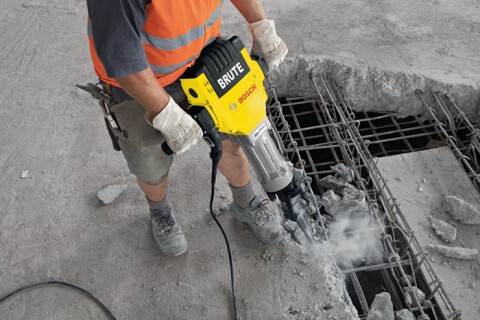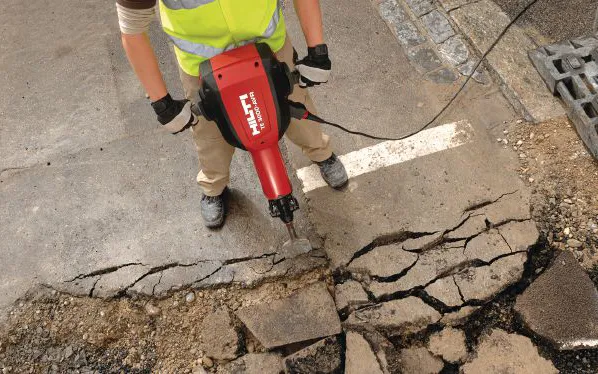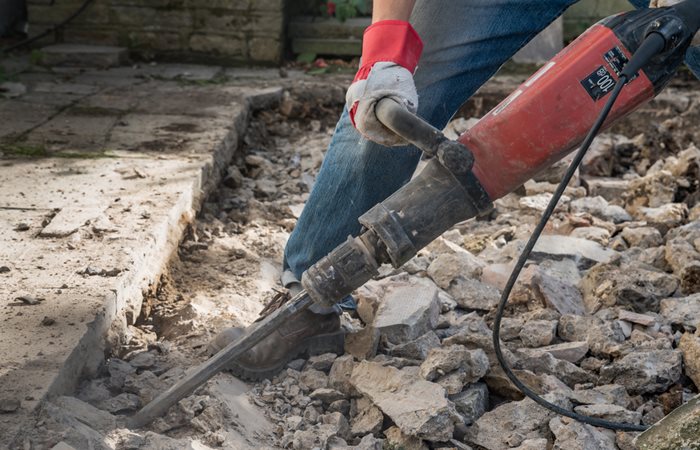Concrete is one of the most durable and versatile construction materials used in buildings, infrastructure, and projects worldwide. Its high compressive strength and longevity make concrete an ideal foundation for structures and surfaces exposed to heavy use and external elements.
However, the strength and resilience of cured concrete can also make it very difficult to drill into or even break if the need arises. This is where hammer drills come in handy. But can a hammer drill actually break concrete?
What is a Hammer Drill and How Does it Work?
A hammer drill, also sometimes known as a rotary hammer, is a power tool specifically designed for drilling into dense, heavy-duty materials like concrete, stone, and masonry. Here are some key features that enable a hammer drill to bore into hardened concrete:
- Impact Mechanism: Hammer drills have an impact mechanism that delivers a short, powerful downward hammer blow to the drill bit as it rotates. This hammering action provides a drilling force up to 10 times greater than a standard power drill.
- Powerful Motor: The motor of a hammer drill spins the drill bit under high torque to grind away material. Higher wattage motors (800+ watts) generate greater drilling power.
- Special Drill Bits: Hammer drills use special drill bits tailored to concrete drilling. These tungsten carbide tipped bits are more rugged and resistant to abrasion from the aggregate in concrete.
When the rotating, hammering drill bit is pressed against a concrete surface, the hammering action drives the drill bit into the material while the rotation pulverizes and grinds up the concrete to penetrate deeper. This combination allows a hammer drill to successfully drill holes and set anchors in concrete.

Factors That Determine If a Hammer Drill Can Break Concrete
The ability for a hammer drill to break concrete depends on several factors:
Hammer Drill Power and Impact Energy
The power output and impact energy are the most important factors determining if a hammer drill can break through concrete.
- Power Output: Higher wattage hammer drills in the 1000+ watt range have the best concrete drilling and breaking capability. More motor power equals greater impact energy and drill bit rotation force.
- Blow Energy: This measures the single-strike energy of the hammering mechanism. Hammer drills with blow energy of 4 joules or more deliver enough impact power to break thicker concrete.
- Blows per Minute (BPM): Hammer drills deliver hundreds to thousands of pulverizing hammer blow impacts per minute to the drill bit. More BPM allows faster penetration into tough concrete.
- High Torque: Motor torque rating indicates the twisting and grinding force applied to the drill bit. More torque can power through hardened concrete better.
Concrete Thickness and Strength
Trying to break thinner softer concrete is much easier for a hammer drill compared to thicker high strength concrete:
- Concrete Thickness: Breaking 6 inches of standard concrete is reasonable for an average hammer drill. But concrete a foot thick or greater requires heavy duty tools.
- Concrete Strength: Standard concrete has a compressive strength of 3,000 to 4,000 PSI. Breaking concrete above 5,000 PSI is extremely difficult without commercial equipment.
Drill Bit Type and Condition
Hammer drill bits tailored for concrete drilling will break concrete better than standard drill bits:
- Concrete Drill Bits: Use hammer drill bits made from tungsten carbide which resists wear better. The drilling end should have a flattened, spade shape to deliver impact force over a broader area.
- Bit Diameter: Larger diameter concrete drill bits exert higher torque and frontal pressure on the concrete. 1/2” and 3/4” bits fare better than smaller diameters.
- Sharp Bit: A sharp, undamaged concrete drill bit focuses the hammering action and rotating friction into a smaller area to break concrete more easily. Dull, worn bits distribute the force over a wider area less effectively.
Steps to Break Concrete with a Hammer Drill
Here is a step-by-step guide to break concrete with a hammer drill:
- Mark the Area – Use a concrete chisel to outline the region be removed. Make it 6 inches wider than final hole size needed.
- Prepare Work Area – Clear any dirt, debris, wires/pipes from the concrete surface. Vacuum up dust if working indoors.
- Select Safety Gear – Wear safety glasses, dust mask, ear protection, gloves, long sleeves and pants.
- Pick a Quality Hammer Drill – Choose an 1100+ watt hammer drill with impact energy of at least 4 Joules (check drill specs). Use a 1/2” or 3/4” tungsten carbide tipped concrete drill bit.
- Start Drilling – Place drill bit against outlined area at a 45 degree angle applying light pressure. Then gently increase pressure, but don’t force the drill. Let the hammering action penetrate the concrete while guiding the drill to stay inside outlined marks.
- Drill Series of Overlapping Holes – Drill holes in rows spaced 2 inches apart both horizontally and vertically across outlined removal area. Overlap holes to fracture the concrete. Move the drill constantly to distribute force evenly and avoid bit damage.
- Switch to Chisel – Once finish drilling all holes across removal area, switch to a concrete chisel tool attached to the hammer drill (or use hand chisel). Position chisel inside the holes at angles and edges of designated area. Turn hammer drill to “Chisel Only” mode or if hand chisel, strike it forcefully with a drilling hammer.
- Break Concrete – As you chisel, the rows of drilled holes will propagate cracks through the concrete. Keep chiseling along hole edges and lines until concrete fractures and lifts up. Then pry and remove broken pieces. Wear eye and hand protection as concrete chips fly when it separates.
- Smooth and Clean Hole – Use a masonry disc grinder (or chisel hammering carefully) to smooth down rough concrete edges around the hole. Vacuum dust and debris out of hole.
With the right hammer drill, drill bits and technique, concrete can be busted up. But don’t attempt drilling without safety precautions due to flying fragments.

Safety Tips When Operating a Hammer Drill
Hammer drilling concrete can generate thick dust and flying chips at high velocity during the break process. To drill safely:
- Wear ANSI-approved eye protection to prevent concrete pieces from damaging eyes
- Use N95 respirator mask & avoid inhaling concrete dust due to silica
- Wear hearing protection – hammer drills generate loud noise up to 105dB
- Long sleeve shirt, pants, gloves shield skin from abrasions & cuts
- Secure loose hair and clothing to prevent tangling in drill bit
- Check if electrical cords are rated for hammer drill higher power draw
- Ensure work area has adequate lighting to see clearly
- Avoid drilling concrete overhead which rains material down on the face & eyes
- Step firmly on stepladder & have someone hold it when drilling above chest level
- Keep proper balance and footing when operating the drill
Hammer drilling concrete has extreme cutting power, so keep fingers, hands and body away from the drill bit or chisel end while activated. Don’t wear jewelry which can catch on drill parts spinning violently.
Stay safe using common sense so that breaking concrete goes smoothly!
Frequently Asked Questions (FAQ’s)
What is the easiest way to break concrete?
For small concrete removal jobs, use a demolition jackhammer which provides powerful hammering action to fracture concrete rapidly across wide areas with less physical exertion required. Using proper jackhammer technique allows busting concrete easily.
For medium jobs, use an 80 lb 3000 BPM electric rotary hammer combined with masonry chisel tools to quickly chip out concrete after drilling initial holes. Limit overhead drilling to reduce arm strain. Wear a respirator mask due to extreme dust.
Hiring professional concrete removal contractors represents the easiest approach for large surface areas or thick slabs over 6 inches. Contractors use Dexpan non-explosive expansive grout injection rather than jackhammering to painlessly expand and crack concrete so it lifts up in chunks only requiring prying tools. Minimal noise, dust and labor!
How thick of concrete can a hammer drill break?
The concrete thickness a hammer drill can break depends primarily upon tool impact energy, power, and proper technique.
On average, medium homeowner 1200 watt hammer drills with 5 Joules of impact force can penetrate normal 3000 PSI concrete up to 6 inches thick if using the optimum concrete drill bits, row hole drilling approach and chisel work. Upgrading to heavy duty 1600+ watt professional rotary hammers enables busting 8 inches concrete blocks reasonably.
Extreme duty hammer drills approaching 3000 watts with an SDS-Max chuck generating over 15 Joules of impact energy are required to drill completely through a 12 inch thick poured slab of standard concrete for removal. Ensure to use quality properly sized tungsten carbide drill bits for longevity during thick penetration. Widening holes diagonally allows better propagation of fracture cracks.
For best productivity removing thicker reinforced concrete above 8 inches without exhaustive effort, consider hiring professional concrete demolition crews instead who use more advanced techniques involving expansive grout busters, diamond wire saws or pneumatic breakers.
Do I need a special drill bit to break concrete?
Yes, using the right hammer drill bits engineered specifically to withstand high-impact drilling concrete dramatically eases breaking concrete and improves hole drilling speed versus standard metal/wood bits.
Look for tungsten carbide tipped bits labeled for “Concrete Drilling” duty. Their dense manufacturing and spade shaped ends focused hammering force better. Match bit diameter size to hammer drill impact energy level and rigidity. Larger hammer drills over 800 watts accept 1/2”, 5/8 or 3/4” bit diameters for most residential concrete drilling jobs.
Longer bits 8”+ disperse damaging heat & retain centering stability. Flushing holes periodically with water while drilling extends bit lifespan in hard aggregate concrete that wears bits faster. Check bits regularly for smoothing, cracks or metal pullout indicating replacement time. Proper concrete drill bits save money and unnecessary efforts when breaking concrete slabs or walls.
Conclusion and Key Takeaways
- Hammer drills generate hammering blows mixed with drill bit rotation allowing concrete penetration
- Sufficient impact power (5+ Joules), high drill torque and matched tungsten carbide concrete drill bits are required to successfully break concrete
- 4-6 inches is typical max concrete thickness an average hammer drill can break through
- Row drill holes across removal area then chisel edges to propagate fracture cracks through slab
- Expanding chemical grout injection makes thick concrete removal much simpler
- Safety gear protects against flying debris, harmful silica dust and loud noise
With specialized tools, uncomplicated methods and essential precautions, breaking concrete with a hammer drill is achievable for small repair jobs or installing electrical conduits and plumbing in existing structures. Understanding the concrete material strength, targeted break thickness and working smart with the proper drill avoids frustration. Hammer safely!
